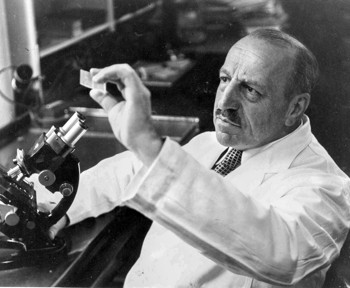FACULTY
Faculty Legends: Jerry Hass and Dr. George Papanicolaou
Finance professor Jerome "Jerry" Hass taught many generations of students at the Samuel Curtis Johnson Graduate School of Management for 46 years.

Jerome "Jerry" Hass See larger image
His down-to-earth persona and humble demeanor co-existed beautifully with his academic brilliance and commitment to teaching and learning, said Soumitra Dutta, dean of Johnson. "The ease with which he lived as farmer, academician, small-business owner, mentor, friend and even travel guide led one of his longtime colleagues at Johnson to dub him 'the working man's professor,'" Dutta said of Hass, who died this past winter.
Hass began his academic career in 1967 as a lecturer, eventually earning tenure as professor of finance and business strategy and the Alan Krause Faculty Fellow in Real Estate Finance.
Former students described him as "a warm, approachable genius" and "a great man, with a great wit." One graduate student wrote: "Thank you for your great teaching, your simplicity and your bucket of home-grown green apples at office hours."
While Hass' engaging teaching style earned students' loyalty, he also was a nationally recognized expert in corporate finance, energy and regulatory economics and policy, applied microeconomics, security analysis and investment management, and business strategy. He co-wrote the seminal managerial finance text, "An Introduction to Managerial Finance," in 1973. And he testified and reported to Congress more than 20 times.
Over the next four decades, he stepped forward to take on roles of all kinds, from co-founding Johnson's first executive MBA program to presiding as faculty marshal at Cornell's commencements for many years.
Hass retired in 2008 yet remained actively involved at Johnson. At a retirement celebration in Sage Hall in June of that year, he quoted the Beatles: "'You say goodbye, I say hello, hello, hello,'" he said. "It's a strange kind of retirement, because I'm not going anywhere!" Indeed, Hass continued to teach at Johnson, using his considerable influence to bring top guest speakers to Sage Hall, and inviting MBA students to take his Lectures in Finance course.
– Shannon Dortch
Dr. George Papanicolaou spent 47 years researching and teaching at Weill Cornell Medical College in New York City, where he transformed his field.
"Dr. Pap" was a pioneer in cytopathology – the diagnosis of diseases on the cellular level – and it was his early human endocrinology studies that led to the "Pap smear" cervical cancer detection test.

Dr. George Papanicolaous See larger image
In the 1940s, before the Pap smear began to be widely used, cervical cancer was the No. 1 killer of women. Now a standard cancer-screening test, it has greatly reduced the death rate for cervical cancer patients.
Papanicolaou was born in 1883 in Greece. A violinist, he enrolled at the University of Athens in 1898 to study humanities and music, and earned a degree from the university's medical school in 1904.
He and his wife, Mary, immigrated to the United States in 1913. Papanicolaou was hired as a research biologist in the Department of Anatomy at what was then Cornell's College of Medicine in 1914.
Papanicolaou first used vaginal smears to examine the cells of guinea pigs; he began studying human vaginal cytology in 1920. His earliest studies at the Woman's Hospital and Cornell clinic examined the cellular changes of ovarian and uterine physiology; he later began using this method to diagnose pregnancy and to detect uterine cancer.
When Papanicolaou presented a paper on this new method of early cancer diagnosis in 1928, pathologists and others in the field showed little enthusiasm. He spent the next decade expanding his studies in human endocrinology. In 1943 Dr. Herbert Traut, a gynecological pathologist, and Papanicolaou published "Diagnosis of Uterine Cancer by the Vaginal Smear." Two years later, the newly established American Cancer Society pushed to educate the profession about the Pap smear. Other scientists began to study his technique to confirm its usefulness as a diagnostic tool, and some hospitals began using the Pap smear to detect cervical cancer.
Papanicolaou taught the first course in cytology at the medical college in 1947. His test began to be used to detect and study other forms of cancer and for better understanding of sterility, the menstrual cycle and hormone therapy.
In 1957, Papanicolaou retired as a professor of clinical anatomy, but a few years later continued his research at the Cancer Institute of Miami, later named the Papanicolaou Cancer Research Institute.
– Elizabeth M. Shepard